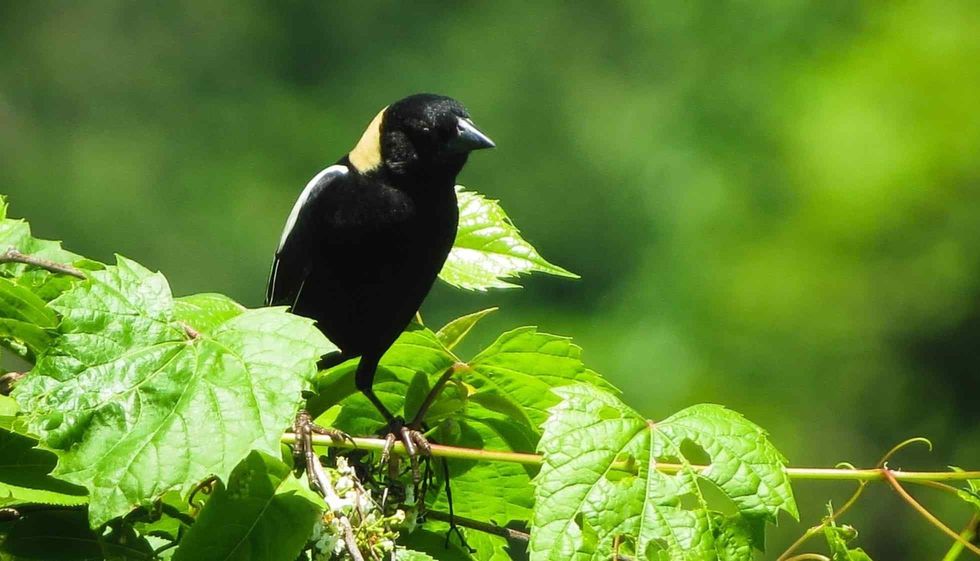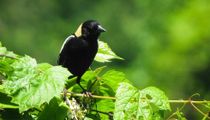The bobolink is a small American bird of the New World blackbird variety. It is also the sole American bird belonging to the genus Dolichonyx.
The bobolink was also known as the 'ricebird' because it had a habit of eating large amounts of grains from rice fields. The name of the species of this bird 'oryzivorus' means 'rice-eating' to describe this habit of the bird. This bird is also known as the 'reedbird' as it is found in grassy meadows and fields.
Bobolinks are known for their long-range migration over long distances and for wintering in Central and Southern America. This bird species is not as abundantly found as it once was, because of the destruction of their habitat including grasslands, meadows, and hayfields.
Bobolinks are also called 'butterbirds' in Jamaica as they can become quite fat after eating large amounts of rice so are often hunted down and eaten by people.
Keep reading for more amazing facts about the bobolink bird! If you like this article with some great facts about the bobolink, you can also check out our other articles with interesting facts about the western kingbird and the prothonotary warbler.
Bobolink Interesting Facts
What type of animal is a bobolink?
A bobolink (Dolichonyx oryzivorus) is a type of bird.
What class of animal does a bobolink belong to?
The bobolink (Dolichonyx oryzivorus) belongs to the Aves class of animals.
How many bobolinks are there in the world?
The exact number of bobolink birds has not yet been recorded by scientists and researchers. However, there is no need to be alarmed about the population of these migrating birds as they are considered to have a stable population.
Where does a bobolink live?
The bobolink species (Dolichonyx oryzivorus) is usually found in a large geographical range extending from the northern part of the United States of America to the southern part of Canada. While they are wintering, bobolinks go to southern South America in the countries of Brazil, Uruguay, Paraguay, and Argentina.
What is a bobolink's habitat?
The primary habitat of the American bird bobolink is found in open meadows, large grounds, wetlands, and grasslands. During winter, they settle in the grassy hayfields of southern South America.
Who do Bobolinks live with?
The bobolink is an American bird that is quite territorial during the breeding season. However, they are not solitary birds. They are often found in large flocks, especially during migration. These flocks consist of thousands of birds who start the journey together.
How long does a bobolink live?
A bobolink has an average lifespan of four to six years.
How do they reproduce?
Bobolinks are North American birds that exhibit polygyny as different males can mate with more than one female. Males engage in an elaborate breeding ritual to attract mates that involve both singing and flying.
The breeding season of bobolinks starts in late April and lasts until early June. These birds go back to the same breeding grounds each year for nesting where the females build a nest. After breeding, the birds start to molt and fatten up for their migration.
Females usually have one brood in a year with three to seven eggs in each brood. The female bird incubates the eggs for 10-13 days. Young nestlings are taken care of by both male and female bobolinks alternately and the parents feed their young. Bobolinks feed the young nestlings for 10-13 days before the young leave the nest.
What is their conservation status?
The International Union for Conservation of Nature (IUCN) has listed the bobolink species as Least Concern as they do not consider the population of the bird to be under any imminent threat.
However, due to a loss of habitat, a change in land-use practices, and climate change, the population of this bird is slowly declining especially throughout Canada and throughout Nova Scotia as well.
Bobolink Fun Facts
What do bobolinks look like?
Adult male bobolinks are mostly black with cream-colored necks and a white-colored scapular and lower back. There is an extensive white mark down their back. Adult female bobolinks are light brown with dark stripes on their head. Their wings and tails are dark brown.
How cute are they?
Birds of the bobolink species are quite cute! They can be pretty charming with their melodious songs and lovely coloring, and they are one of the most well-known songbirds in North America.
How do they communicate?
Males of the bobolink species primarily communicate vocally during the breeding season by a rumbling sound that can be almost metallic when you hear it. Other than that, their year-round call sounds like 'bink'.
How big is a bobolink?
The average length of a bird of the bobolink species is between 5.9-8.3 in (15-21 cm). The length of its wingspan is approximately 10.6 in (27 cm). The African lion is almost 10 times the size of a bobolink bird as it can grow up to 5 ft (1.5 m) in size.
How fast can a bobolink fly?
The exact speed of a bobolink while flying has not been recorded yet. However, bobolinks are known to be able to fly for a long distance as migrants without getting tired.
How much does a bobolink weigh?
The average weight of a bobolink bird is 1-2 oz (29-56 g).
What are the male and female names of the species?
Male and female bobolink birds are called 'cocks' and 'hens' respectively.
What would you call a baby bobolink?
A baby bobolink does not have a separate, unique name. However, baby birds are usually referred to as nestlings or chicks. Therefore, a baby bobolink is also referred to as a nestling or a chick.
What do they eat?
The diet of bobolink birds mainly consists of insects and seeds which they forage through grass from the ground. Apart from seeds and insects, the bobolink also feeds upon the armyworm moth.
Therefore, they have also been nicknamed the 'armyworm bird'. They used to feed on rice from rice fields and hay from hay fields but that tendency is not seen much anymore.
Are they dangerous?
North American bobolink birds are not dangerous and are not known to cause any harm to human beings.
Would they make a good pet?
Bobolinks (or the rice bird) would not make a good pet as they are essentially wild birds who like to stay in their habitat of open grassy fields and wetlands. In addition to that, they also go through long-range migration every winter, and birds that are migrants cannot be kept as pets.
Did you know...
The onomatopoeic and amusing poem 'Robert Of Lincoln' written by the American poet William Cullen Bryant was inspired by the bobolink bird and their song. The poem talks about the mating ritual of the bobolink with the flashy male bird and the subdued female bird.
Famous poet Emily Dickinson also wrote many poems about the bobolink bird. Edgar Allan Poe, the American writer, mentioned the bird in his short story 'Landor's Cottage' and the bobolink bird is also referred to in the musical 'Camelot' written by Alan Jay Lerner.
The collective noun used to denote a group of bobolinks is a 'chain'.
What does a bobolink sound like?
Male bobolinks largely depend on singing for communication with others. As the male bobolink enters the breeding grounds, it marks its range of territory by singing a song.
While attracting a mate during the breeding season, males sing and fly in the sky. The flight pattern of males is exceptional and they exhibit a unique flight pattern to prove the superiority of their genes.
Their normal call is a soft 'chuk' sound while their flight call is more musical and sounds like 'bink'. The normal call or song of birds of this family also changes when they are feeling aggressive or if they want to attract mates.
What is so striking about the bobolink bird?
The most striking feature of the bobolink bird is its ability to complete long-distance migration during the winter season. Bobolinks fly one of the longest distances seen in any neotropical songbird.
Their migration range is quite large as they are found wintering in Brazil, Paraguay, and Argentina. Due to this migration, sometimes they are also sighted in Europe. They have excellent navigation skills and can navigate through magnetic fields due to the magnetite present in their skulls!
Here at Kidadl, we have carefully created lots of interesting family-friendly animal facts for everyone to discover! Learn more about some other birds from our ovenbird facts and palm warbler facts pages.
You can even occupy yourself at home by coloring in one of our free printable bobolink coloring pages.









